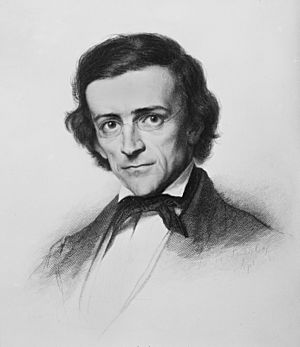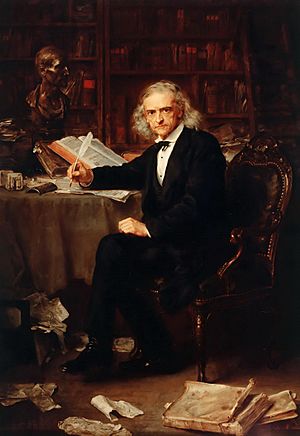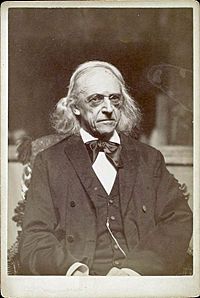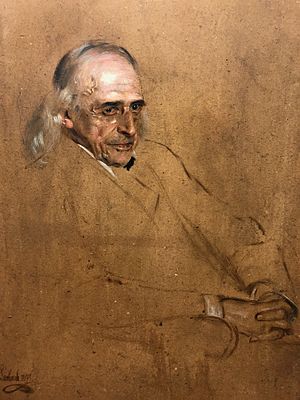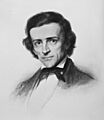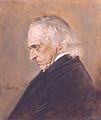Theodor Mommsen facts for kids
Quick facts for kids
Theodor Mommsen
|
|
|---|---|

Christian Matthias Theodor Mommsen
|
|
| Born |
Christian Matthias Theodor Mommsen
30 November 1817 Garding, Schleswig
|
| Died | 1 November 1903 (aged 85) |
| Nationality | German |
| Alma mater | University of Kiel |
| Awards | Pour le Mérite (civil class) Nobel Prize in Literature 1902 |
| Scientific career | |
| Fields | Classical scholar, jurist, ancient historian |
| Institutions | University of Leipzig University of Zurich University of Breslau University of Berlin |
| Notable students | Eduard Schwartz Otto Seeck |
Christian Matthias Theodor Mommsen (born November 30, 1817 – died November 1, 1903) was a very important German scholar. He studied many things, including ancient history, law, and archaeology. He was also a journalist and a politician.
Mommsen is known as one of the greatest experts on ancient Rome from the 1800s. His work on Roman history is still very important for people studying it today. In 1902, he won the Nobel Prize in Literature. He received this award for being "the greatest living master of the art of historical writing." This was especially for his huge book, A History of Rome. He was also a member of the German parliament. His ideas about Roman law greatly influenced the German civil code.
Theodor Mommsen's Life Story
Mommsen was born in 1817 in a town called Garding in Schleswig. This area was part of Denmark back then. He grew up in Bad Oldesloe, where his father was a minister. He mostly studied at home. He also spent four years at a school called Christianeum in Altona. He learned Greek and Latin and finished school in 1837.
Mommsen studied law at the University of Kiel from 1838 to 1843. He earned a degree in Roman Law. During this time, he lived with Theodor Storm, who later became a famous poet. Mommsen, Storm, and Mommsen's brother Tycho even published a book of poems together.
Thanks to a grant from the Danish king, Mommsen traveled to France and Italy. There, he studied old Roman inscriptions (writings carved into stone). During the revolutions of 1848, he worked as a reporter. He supported Germany taking over Schleswig-Holstein.
The Danes forced him to leave the country. In the same year, he became a law professor at the University of Leipzig. But he had to leave this job in 1851 because he protested against a new law in Saxony. The next year, he became a professor at the University of Zurich. Then, in 1854, he became a law professor at the University of Breslau. In 1857, he joined the Berlin Academy of Sciences as a research professor. He also helped create and manage the German Archaeological Institute in Rome.
In 1858, Mommsen became a member of the Academy of Sciences in Berlin. He also became a professor of Roman History at the University of Berlin in 1861. He taught there until 1887. He received many awards for his academic work. These included the Pour le Mérite medal in 1868 and honorary citizenship of Rome. He also won the Nobel Prize in Literature in 1902 for his main work, Römische Geschichte (Roman History). He is one of the few non-fiction writers to win the Nobel Prize in Literature.
In 1880, a fire broke out in Mommsen's library at his home in Berlin. He tried to save important papers but was burned. Several old manuscripts were destroyed, including some borrowed from other libraries.
Mommsen was a very hard worker. He would wake up at five in the morning to do research. People often saw him reading while walking in the streets.
Mommsen had sixteen children with his wife, Marie. Their oldest daughter, Maria, married Ulrich von Wilamowitz-Moellendorff, another great classical scholar. His grandson, Theodor Ernst Mommsen, became a history professor in the United States. Two of his great-grandsons, Hans Mommsen and Wolfgang Mommsen, were also famous German historians.
Mommsen's Important Works
Mommsen published over 1,500 works. He created a new way to study Roman history. He was a pioneer in epigraphy, which is the study of inscriptions found on old objects. His most famous work is his unfinished History of Rome. But his most important work today might be the Corpus Inscriptionum Latinarum. This is a huge collection of Roman inscriptions he helped create for the Berlin Academy.
- Mommsen's History of Rome: This famous work came out in three volumes between 1854 and 1856. It covered Roman history up to the end of the Roman Republic and the rule of Julius Caesar. Mommsen admired Caesar greatly. He compared the political ideas of ancient Rome to his own time. The book became very popular and was praised by scholars. Mommsen never wrote a fourth volume about the later Roman Empire, even though many people wanted it.
- The Provinces of the Roman Empire from Caesar to Diocletian (1885): This book was published as volume 5 of his History of Rome. It describes all the Roman regions during the early imperial period.
- Roman Constitutional Law (1871–1888): This detailed study of Roman constitutional law in three volumes was very important for ancient history research.
- Roman Criminal Law (1899)
- Corpus Inscriptionum Latinarum: Mommsen was the main editor of this huge collection of Latin inscriptions, starting in 1861.
- Digesta (of Justinian): He edited this work between 1866 and 1870.
- Iordanis Romana et Getica (1882): This was Mommsen's important edition of Jordanes' The Origin and Deeds of the Goths. It is often called Getica.
- Codex Theodosianus: He edited this work, which was published after his death in 1905.
- He also wrote over 1,500 other studies and papers on specific topics.
Mommsen as an Editor and Organizer
Mommsen was a secretary at the Berlin Academy from 1874 to 1895. During this time, he organized many scientific projects. Most of these projects involved publishing original historical documents.
Corpus Inscriptionum Latinarum
Early in his career, Mommsen wanted to create a collection of all known ancient Latin inscriptions. He started this work by publishing inscriptions from the Naples area in 1852. The full Corpus Inscriptionum Latinarum was planned to have sixteen volumes. Mommsen oversaw the publication of fifteen of these volumes during his lifetime. He wrote five of them himself. The main rule for this collection was that all copies of inscriptions had to be checked against the original writings.
Other Projects
Mommsen also published important collections of Roman law. These included the Corpus Iuris Civilis and the Codex Theodosianus. He also played a big role in publishing the Monumenta Germaniae Historica. This is a collection of texts from the Church Fathers. He also worked on research about the Limes Romanus (Roman frontiers) and many other projects.
Mommsen as a Politician
Mommsen was a member of the Prussian House of Representatives from 1863–66 and again from 1873–79. He was also a member of the Reichstag (German parliament) from 1881–1884. He was part of different liberal political parties. He cared a lot about education and academic policies.
Even though he supported German Unification, he was not happy with the politics of the new German Empire. He was worried about its future. Mommsen strongly disagreed with Otto von Bismarck about social policies in 1881. He spoke so strongly that he almost faced legal trouble.
As a liberal nationalist, Mommsen believed that different ethnic groups should become part of German society. In 1879, a colleague started a campaign against Jewish people. Mommsen strongly opposed this. He wrote a strong pamphlet speaking out against these ideas. He thought that Jewish people could become part of German society by adopting some German customs.
How Mommsen Influenced Others
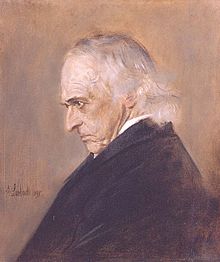
Bernard Shaw, who also won a Nobel Prize, said that Mommsen's ideas about Julius Caesar inspired his play Caesar and Cleopatra.
A famous naval historian named Alfred Thayer Mahan got the idea for his main book, The Influence of Sea Power Upon History, while reading Mommsen's History of Rome.
There is a high school named after Mommsen in his hometown of Bad Oldesloe, Germany. His birthplace, Garding, calls itself "Mommsen-Stadt Garding" (Mommsen City Garding).
Mark Twain's Story About Mommsen
The famous American writer Mark Twain visited the University of Berlin in 1892. He attended a big dinner there. Mark Twain was a special guest, sitting at the main table with about twenty important professors. He saw something amazing happen:
Twain wrote: "When it seemed like all the important guests were already seated, those three bugle-blasts rang out again. And once more, swords came out of their cases. Who could this late arrival be? No one seemed to care. Still, people looked towards the distant entrance. We saw the shiny silk and the raised sword of a guard of honor moving through the crowd. Then we saw that side of the room stand up. It rose like a wave as the guard moved forward. No one else had received such a great honor. There was an excited whisper at our table—'MOMMSEN!'—and the whole room stood up. They stood up and shouted and stomped and clapped and banged their beer mugs. It was just a storm of applause!"
"Then the small man with his long hair and Emersonian face moved past us and sat down. I could have touched him—Mommsen!—just think of it! ... I would have walked many miles to see him, and here he was, without any trouble or cost. Here he was, dressed in a huge, humble way that made him look like any other man."
Images for kids
See also
 In Spanish: Theodor Mommsen para niños
In Spanish: Theodor Mommsen para niños


